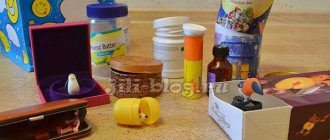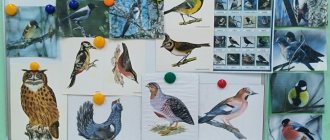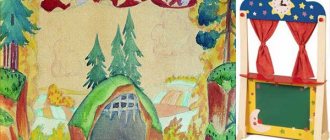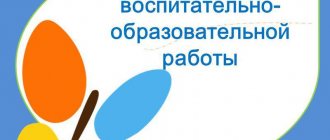Plan of educational work in the senior group
Health-improving gymnastics after sleep. Breathing exercises. Walking along massage paths.Conversation “What’s the weather like outside” (children’s impressions of the weather, about the frosty morning)
Conversation on the topic “Winter is coming, it’s calling.”
With the help of the works of Russian poets, awaken in children interest and love for their native nature and Russian winter. Clarify children's knowledge about winter natural phenomena, teach them to talk about the phenomena described in poems.
Role-playing games: “Family”, “Bus trip to the winter forest”, “Family preparing for the New Year”, “Library”.
Continue work to develop and enrich the plots of games: expand children’s independence in choosing a role, developing and implementing a plan, develop the ability to select objects and attributes for the game, develop the ability of children to agree on what they will do.
Didactic games: “Say the opposite”, “Say it correctly”, “What’s for what?” “Fold a New Year’s card”, “When this happens.”
Develop attentiveness and observation, teach children to play following certain rules, train children in composing a whole object from its parts, and consolidate children’s knowledge about the seasons.
Educational game. “Whose trace?”
To clarify and consolidate children’s knowledge about wild animals and their way of life in the winter forest. To introduce the types of tracks of wild animals, to develop the ability to correlate the animal with the tracks it left in the winter forest. Develop logical thinking, imagination, coherent speech.
Theatricalization: dramatization of the fairy tale “Wintermovie”. Table theater: “Little Fox and the Wolf.”
Develop the ability to perform simple performances based on familiar literary works; use known expressive means (intonation, facial expressions, gestures) to embody the image.
Independent activity of children.
S/r games optional. Monitoring children's relationships, promoting a favorable psychological climate.
Cognitive, research and productive (constructive) activities.
Topic: “Properties of water.” Expand children's understanding that water in frost turns into ice, icicles, snow, and melts in a warm room. Introduce the life of animals and birds in the winter forest.
Independent activity of children.
Printed board games optional. Development of thinking, memory, attention, independence, perseverance.
Games with building material “Builder No. 3”, LEGO
Learn to think about and plan practical actions, reason, justify your idea.
Didactic game: “Prepare the bunny and the squirrel for winter”
Continue to acquaint children with changes in the color of the fur of forest animals with the arrival of winter, and find out the cause of this phenomenon.
"Frost patterns"
Continue teaching children to draw frosty patterns in the style of lace making. Create conditions for experimenting with paints to obtain different shades of blue. Improve your technique of drawing with the end of a brush. Develop a sense of form and composition.
Offer children paints and plasticine for children to do independently.
Develop creativity and hand motor skills.
Reading of the poem by V. Berestov: “Snowfall”, fairy tales “Wintermovie”, arr. I. Sokolova - Mikitova, S. Yesenina “Winter Sings and Calls”, Y. Akim “First Snow”.
Teach children to listen carefully, understand the meaning of what they read, and convey their attitude to the content of the work.
Listening to Tchaikovsky "Winter"
Household work: washing toys.
Discuss with the children the purpose of this work, teach them to outline a plan for joint actions, and distribute responsibilities for preparing the necessary equipment. Foster a work culture and respect for materials and tools.
The plan is a summary of direct educational activities with preschoolers in the senior group.
The plan is a summary of direct educational activities with preschoolers in the senior group.
Topic :
“Bewitched by the Enchantress of Winter, the forest stands...”
Integration of educational areas
: “Communication”, “Artistic creativity”, “Music”, “Reading fiction”, “Cognition”, “Physical education”.
Objectives:
· develop children’s ability to compose a descriptive story of the winter forest, activate comparisons and metaphors in children’s speech.
("Communication"); · develop speech breathing. ("Communication"); · develop clear diction through tongue twisters (“Communication”); · develop children’s ability to analyze the sound composition of the word “forest”. ("Communication"); · enrich children’s vocabulary with words: “fringe”, “tremble”, “flare up”, “dazzling”. ("Communication"); · cause the manifestation of positive emotions when listening to a piece of music. ("Music"); · develop imaginative perception, aesthetic feelings by looking at reproductions of paintings of a winter forest (“Artistic Creativity”) · develop creative abilities through images of a winter forest. (“Artistic creativity”). · introduce children to Fyodor Tyutchev’s poem “The Enchantress in Winter...”, activate the sensory perception of the artistic word, promote the figurative perception of the poem, reveal the author’s attitude to nature, cultivate a sense of beauty and interest in the artistic word. (“Reading fiction”) · form ideas about ordinal counting up to 7. (“Cognition. FEMP”); · develop the ability to compare trees by height. (“Cognition. FEMP”); · cultivate in children the ability to listen to each other without interrupting. (“Socialization”) · develop motor activity and fine motor skills through playful motor tasks (“Physical Education”). Methods and techniques:
Practical: game exercise “Blow on a snowflake”;
dynamic pause “I’m not afraid of frost”, creative task “Illustration for a book” (children’s depiction of a winter landscape); finger game “Walk”; didactic games “What different trees are in winter”, “Which tree is taller”; dynamic pause “In December.” Visual: demonstration of reproductions of paintings with a winter landscape, examination of children's drawings; design of the group “Winter Forest”. Verbal: game exercise “Magic words”; children's stories for a book about the winter forest; conversation; reading a work of art by F. Tyutchev; didactic game “Find the lost sound.” Materials and equipment:
multimedia projector, screen, PC, text of F. Tyutchev’s poem, voice recorder, Demonstration: slides (reproductions of winter landscapes);
subject pictures of various trees of different heights in winter. Handout: reproductions of paintings by Levitan and Shishkin according to the number of children; paper snowflakes for each child; tinted sheets of paper, glasses of water, brushes of different sizes, gouache, watercolors, colored pencils, wax crayons, fabric napkins, pictures of various trees in winter of different heights according to the number of children. Forms of organizing joint activities
| Children's activities | Forms and methods of organizing joint activities |
| Motor | 1. Dynamic pause “In December”, “I’m not afraid of frost” Purpose: · develop children’s motor activity · develop the ability to combine words with movement 2. Finger game “Walk” Purpose: develop fine motor skills |
| Productive | Creative task “Illustration for a book” (children’s drawings). Goal: to develop creativity through the image of a winter forest. |
| Cognitive and research | 1. Didactic game “Which tree is taller.” Goal: develop the ability to compare trees by height. 2. Didactic game “What different trees are in winter” Purpose: to form ideas about ordinal counting up to 7. |
| Communicative | 1. Game – journey “Into the winter forest”. Goal: to develop children’s ability to compose a descriptive story of a winter forest, to activate comparisons and metaphors in children’s speech. 2. Compiling stories for the book “Bewitched by the invisible, the forest slumbers under the fairy tale of sleep.” Goal: to develop coherent speech, enrich children’s vocabulary with words: “fringe”, “tremble”, “flare up”, “dazzling”. 3. Game exercise “Blow on a snowflake” Purpose: to develop speech breathing. 4. Game exercise “Magic words” Goal: to develop clear diction through tongue twisters. 5. Game “Sound Lost” Purpose: to develop children’s ability to analyze the sound composition of the word “forest”. 6. Conversation about the forest in winter. Goal: · develop coherent speech · develop the ability to answer a question in a complete sentence. |
| Musical and artistic | Examination of slides with reproductions of paintings by I.I. Levitan “Forest in winter”, I.I. Shishkin “Winter in the Forest” and other landscapes to the music “In the Winter Forest”. Goal: · develop imaginative perception, aesthetic feelings by looking at reproductions of paintings of a winter forest · develop creative abilities through images of a winter forest. · cause the manifestation of positive emotions when listening to a piece of music |
| Reading (comprehension) | Reading Fyodor Tyutchev’s poem “In the Enchantress in Winter...” Purpose: to activate the sensory perception of the literary word, to promote the figurative perception of the poem, to reveal the author’s attitude to nature, to cultivate a sense of beauty and interest in words. |
Logic of educational activities
| № | Activities of the teacher | Pupils' activities | Expected results |
| 1. 1 | Travel game “Into the winter forest” | Compiling a descriptive story of a winter forest, using comparisons and metaphors in speech. | Increased experience in writing a descriptive story |
| 2. | Show slides with reproductions of paintings by I.I. Levitan “Forest in Winter”, I. I. Shishkin “Winter in the Forest” and other winter forest landscapes to the music “In the Winter Forest.” | Examination of slides with reproductions of paintings by I.I. Levitan “Forest in Winter”, I. I. Shishkin “Winter in the Forest” and other winter forest landscapes to the music “In the Winter Forest”. | Conditions have been created for the development of imaginative perception, aesthetic feelings, and the manifestation of positive emotions when listening to a piece of music. |
| 3. | Reading the poem by F. Tyutchev “In the Enchantress in Winter...”. Bewitched by the Enchantress of Winter, the forest stands - And under the snowy fringe, motionless, mute, it glitters with a wonderful life. And he stands, bewitched, - Neither dead nor alive - Enchanted by a magical dream, All entangled, all shackled With a light downy chain... Does the winter sun place its scythe ray on him - Nothing in him will tremble, He will all flare up and sparkle with Dazzling beauty. | Listening to F. Tyutchev’s poem “In the Enchantress’s Winter...” | Conditions have been created for activating the sensory perception of the artistic word, the figurative perception of the poem, for cultivating a sense of beauty and interest in the word. The vocabulary has been replenished with the words “fringe”, “flutter”, “flare”, “dazzling” |
| 4. | Conversation about the forest in winter: · What feelings come over you? · What colors are used to depict the forest in winter? · What sounds did you hear? · What smells did you smell? | Complete answers to the teacher’s questions using words in speech | Conditions have been created for the development of coherent speech in children |
| 5. | Game exercise “Blow on a snowflake” | Blow on a paper snowflake so that it flies off the sheet of paper. | Conditions have been created for the development of speech breathing and directed air flow |
| 6. | Helps children compose stories for the book “Enchanted by the invisible, the forest slumbers under the fairy tale of sleep.” | Make up stories on a winter theme. | Conditions have been created for the development of coherent speech. |
| 7. | Dynamic pause “In December.” | White - white (Hands raised up, stretched) In December - in December (Turns of the body left and right, arms to the sides) Christmas trees - Christmas trees (Hands raised up, stretched) In the yard - in the yard (Twists of the body left and right, hands on belt) Spins - spins And sings - and sings (Spinning in place) Festive - festive Round dance - round dance. (Clap your hands) Slippery - slippery In December - December (Imitation of sliding with your feet) Hills - hills In the yard - in the yard. (Squats) Voiced - sonorous In December - in December (Arm swings) Songs - songs In the yard - in the yard. (Jumping in place) Spinning and spinning And singing and singing (Spinning in place) Festive - festive Round dance - round dance. (Clap your hands) | Conditions have been created to satisfy children's basic need for movement and relieve static tension |
| 8. | Game exercise “Magic words” (tongue twister) | They pronounce tongue twisters with a gradual acceleration of the tempo of speech: On a winter morning, from the frost, the birch trees ring at dawn. Frost lay on the branches of the spruce tree, the needles turned white overnight. | Conditions have been created for the development of clear diction |
| 9. | Didactic game “Find the lost sound” (sound analysis of words). | Carry out a sound analysis of the word “Forest” - “assemble” the word from individual letters E L S - determine the number of syllables - quantitative and qualitative sound analysis of the word FOREST | Conditions have been created for the development of phonemic hearing and sound-syllable analysis of words |
| 10. | Creative task “Illustration for a book” | Drawing a landscape on the theme “Winter Forest”. | Conditions have been created for the development of creative abilities |
| 11. | Finger game "Walk". | One-two-three-four-five (we straighten our fingers clenched into a fist one by one), We went into the yard for a walk (we use our index and middle fingers to depict a “little man” and walk). We made a snow woman (we imitate making a snowball), We fed the birds with crumbs (we put our fingers together in a pinch), You and I rode down the hill (we run the index finger of one hand along the palm of the other), And we also rolled in the snow (we turn our palms first with the outer side, then with the inner side) . Everyone came home covered in snow! (we shake off our hands) We ate soup (we pretend to bring a spoon to our mouth), we went to bed (we put folded palms to our cheeks) | Conditions have been created for the development of fine motor skills and coordination of hand movements. |
| 12. | Didactic game “What different trees are in winter” | Counting trees up to seven (based on object pictures) | Conditions have been created for FEMP (ordinal counting within 7) |
| 13. | Didactic game “Which tree is taller” | Comparison of the height of various trees in winter (birch is lower than pine, but higher than spruce, etc.) using subject pictures. | Conditions have been created for developing the ability to compare objects (trees) by height. |
| 14. | Dynamic pause “I’m not afraid of frost.” | I am not afraid of frost, I will become close friends with it. The frost will come to me, touch my hand, touch my nose, So I must not yawn, Jump, run and jump! (Perform appropriate movements) | Conditions have been created to satisfy children's basic need for movement and relieve static tension |
| 15. | Reflection: · What did you read the poem about? · What is the name of our book? · What game did we play? · What was shown in the drawings? · What did you find magical in the winter forest? | Children answer questions with complete answers and talk about their mood after class. Tell them what they liked most about the lesson. |



